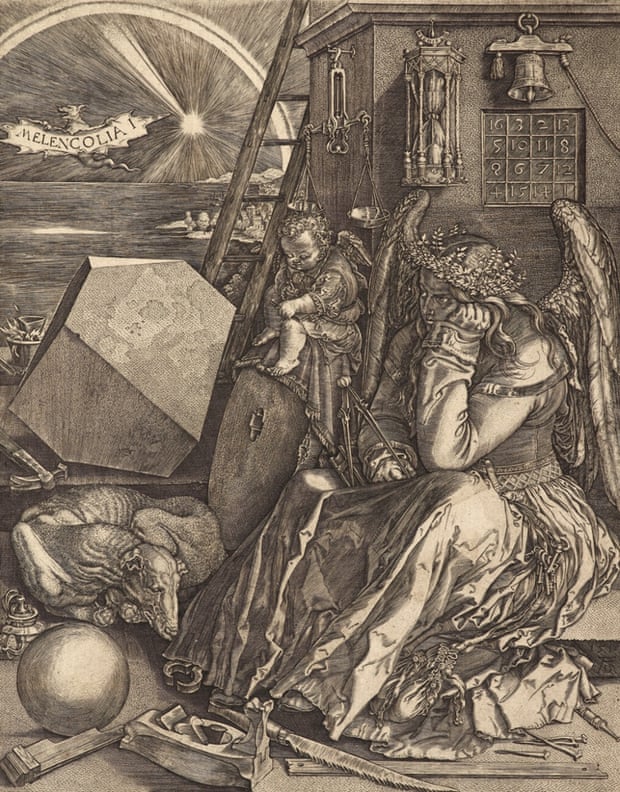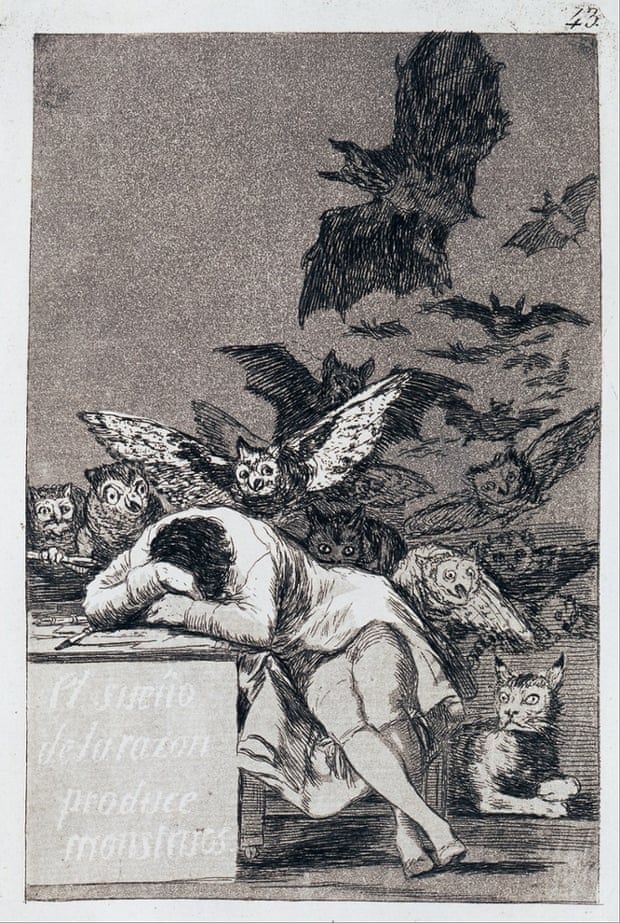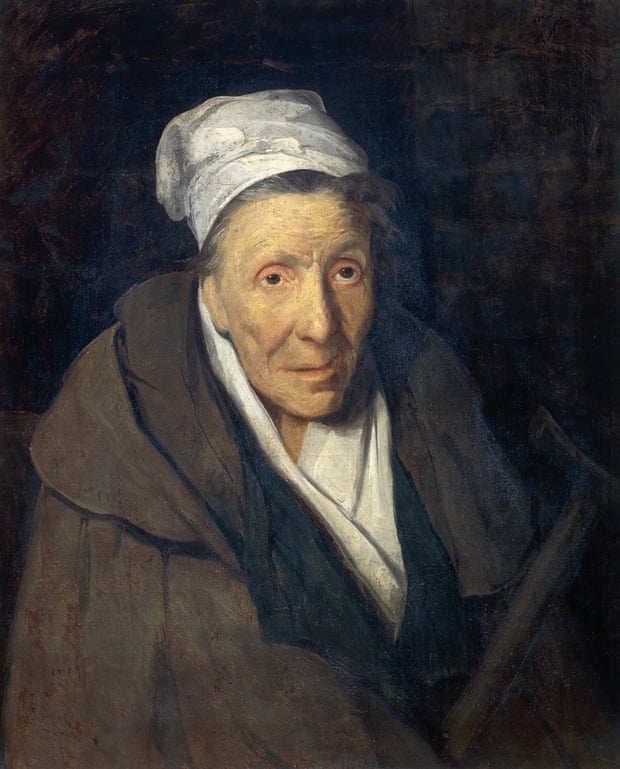A short history of mental illness in art
From Hogarth to Van Gogh, art has challenged our understanding of mental illness. Jonathan Jones’ shares his top ten for our mental health appeal
Jonathan Jones
Tuesday 13 January 2015 10.52 GMT
Art has led the way in seeing mental illness not as alien or contemptible but part of the human condition – even as a positive and useful experience. Modern art has even celebrated mental suffering as a creative adventure. This psychiatric modernism started with the “madness” of Vincent van Gogh and led to work by patients being discovered as a new kind of art. Yet it has much deeper historical roots. Albrecht Durer portrayed genius as melancholic as early as the Renaissance and Romantic painters identified with the “mad”.
Perhaps it is not hard to see why artists often show empathy for what society calls illness: all creativity is an irrational voyage. The idea of going outside yourself to see things afresh is probably as old as the torchlit visions of cave artists and was expressed by the ancient Greek philosopher Plato when he wrote that poetic ecstasy is the only source of divine truth. “Madness is a gift from the gods”, as Plato put it.
1. Vittore Carpaccio – The Healing of the Possessed Man at the Rialto (c. 1496)

This painting of everyday life in 15th century Venice reveals how mental illness was understood and treated in the middle ages. It is sometimes called “The Healing of the Madman”, but “possessed” is closer to contemporary ideas about the mind. For the man being miraculously healed by a priest amidst the human drama of the Rialto bridge has been taken over by a demon. His suffering is neither a medical nor social problem, but a religious experience.
2. Matthias Grunewald – The Temptation of St. Anthony (c. 1512 - 16)

Late medieval artists were fascinated by the story of the early Christian hermit Saint Anthony the Great who was tempted by devils. For Grunewald, this becomes a truly personal and psychological terror, an image of a man whose sanity is under threat. The infinite horrible shapes of the demons are like malformed thoughts. It is a compassionate work, for this is part of the Isenheim altarpiece, painted for a hospital that treated people with disfiguring illnesses. One of the devils has the sores and grey skin that appear in other parts of the altarpiece and evoke the illnesses treated there. Does this swarming scene therefore portray the threat to mental health posed by extreme physical suffering? It influenced German expressionism and is to this day a masterpiece of the threatened mind.
3. Albrecht Durer – Melancholia (1514)

This visionary work of art is both a diagnosis and heroic celebration of what might now be seen as illness. Melancholia was known and experienced in the middle ages, a darkness of the mind resulting from an inbalance of the humours. That darkness is marked on the brooding face of Durer’s spirit of melancholy. In her despond, she appears unable to continue with her great works. She is to judge by her tools a mathematician, geometer, and architect: a Renaissance genius. Durer portrays through this emblem his own inner life and intuits the mind’s complexity. For Melancholy in his eyes is the badge of genius - to aspire to know and create is to slump into despair. Unhappiness is noble, for Durer. This print is arguably the beginning of modern psychology.
4. William Hogarth – The Rake in Bedlam (1733)
The insight of Durer – not to mention Shakespeare and Cervantes – that mental shadows are part of human life was lost on the founders of London’s Bethlem Hospital. The notorious “Bedlam” was founded in the middle ages and may have specialised in mental illness as early as the 14th century. When Hogarth in the 18th century portrayed a young man whose career of gambling and spending had led him there, it was a place where Londoners could come and look at the “mad”.Hogarth shows two “sane” women enjoying the spectacle of madness, which includes people who think they are kings and bishops. Of course, in Hogarth’s view, the boundary between sanity and insanity is not that obvious at all.
5. Francisco Goya y Lucientes – The sleep of reason produces monsters (c. 1799)

Goya’s depiction of a sleeping man – the artist – assailed by monsters of the night is an image of reason’s frailty made at the end of the Enlightenment, the great 18th century movement that sought to change the world with encyclopaedias, scientific demonstrations and the first factories. Goya’s pessimistic yet also compassionate view is that reason only ever rules part of our minds. It must share the world with nightmares. At the dawn of the modern age, this great image echoes old depictions of the Temptations of St. Anthony, whose assailants have not gone away after all.
6. Theodore Gericault – Portraits of the Insane (1822)

In the Romantic age extreme states of mind and inner suffering were the stuff of poetry and art. This mood of introspection opens new eyes on mental health in Gericault’s portraits of the “insane”. He painted ten of these, of which five still exist, all depicting patients of his friend Dr Etienne-Jean Georget. In this painting, there is deep respect and human sympathy for a woman whose illness seems mostly visible as deep unhappiness. Escaping from stereotypes and prejudice, Gericault portrays mental illness as a part of the human condition that he himself - as an artist whose paintings dwell on death and violence - clearly feels close to.
7. Gustave Courbet – Self-Portrait (The Desperate Man) (c. 1843 - 45)

In a moment of Romantic exhilaration Courbet portrays himself as a “madman”, his face ecstatic and terrified. His desperate state of mind is not a shameful sickness but a badge of artistic pride. In a tradition that goes back to Durer’s Melancholia but reached new power in the Romantic age, he equates genius and madness. This face of desperation is the face of the 19th century avant garde, risking and even courting sickness with drink and drugs. Courbet looks like a character in one of Edgar Allan Poe’s stories, his mind unravelling in a way the first modern artists were fascinated by.
8. Vincent van Gogh – Self-Portrait with Bandaged Ear (1889)

Vincent van Gogh was fascinated by a 19th century painting called The Madness of Hugo van der Goes. In this picture the medieval artist Hugo van der Goes – who in real life was confined to a monastery because of mental illness – broods in torment, while those around him despair of helping the afflicted man. Van Goghwrote that he sometimes identified with this painting. Here, shortly after cutting off his own earlobe, he scrutinises himself as a man similarly afflicted. Or is he? Vincent’s eyes are crystal blue, his gaze acute and penetrating. He looks at his wounded face objectively, with deep truth. He is neither “sane” nor “insane” but a fellow human being who speaks to us with courage and honesty.
9. Edvard Munch – The Scream (1893)

Madness is the modern condition in this work of art that has the clarity of a theorem. The Scream is universal. This is how life today makes us feel, says Munch. Far from a pathology afflicting individuals, the desire to scream out in pain and isolation under the wobbly sky is a sane response to an insane world. Munch takes the artistic revaluation of mental illness that started in the Romantic age to its logical conclusion: there is no Bedlam but the world itself.
10. Josef Forster – Untitled work in the Prinzhorn Collection (after 1916)
Once Munch and Van Gogh made “madness” a positive value in modern art, a key to visionary truth, it was only a matter of time before the medical profession too started to see new connections between art and the mind. Before his death in 1933, Dr Hans Prinzhorn assembled a collection of art by mentally ill patients that was the beginning of what is now known as “outsider art”. This example has the eerie power of Goya. From something to be depicted by artists, “madness” has become a source of artistic originality in itself.


.jpg)
.jpg)

No comments:
Post a Comment